
Michelangelo Merisida Caravaggio, known as simply Caravaggio, was an Italian painter active in Rome for most of his artistic life. During the final four years of his life he moved between Naples, Malta, and Sicily until his death. His paintings have been characterized by art critics as combining a realistic observation of the human state, both physical and emotional, with a dramatic use of lighting, which had a formative influence on Baroque painting.
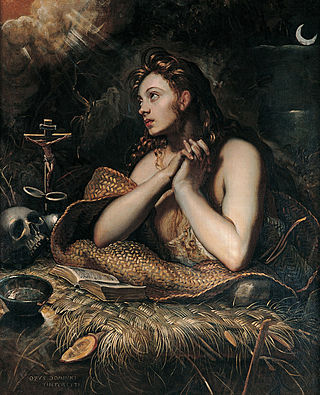
Mary Magdalene was a woman who, according to the four canonical gospels, traveled with Jesus as one of his followers and was a witness to his crucifixion and resurrection. She is mentioned by name twelve times in the canonical gospels, more than most of the apostles and more than any other woman in the gospels, other than Jesus's family. Mary's epithet Magdalene may be a toponymic surname, meaning that she came from the town of Magdala, a fishing town on the western shore of the Sea of Galilee in Roman Judea.
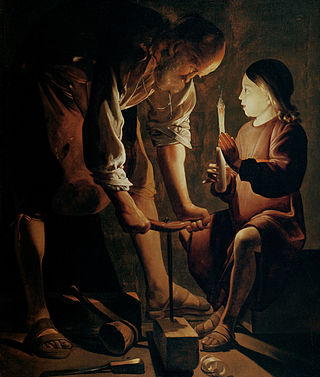
Georges de La Tour was a French Baroque painter, who spent most of his working life in the Duchy of Lorraine, which was temporarily absorbed into France between 1641 and 1648. He painted mostly religious chiaroscuro scenes lit by candlelight.

The Calling of Saint Matthew is an oil painting by Caravaggio that depicts the moment Jesus Christ calls on the tax collector Matthew to follow him. It was completed in 1599–1600 for the Contarelli Chapel in the church of the French congregation, San Luigi dei Francesi in Rome, where it remains. It hangs alongside two other paintings of Matthew by Caravaggio, The Martyrdom of Saint Matthew and The Inspiration of Saint Matthew (1602).

Caravaggio created one of his most admired altarpieces, The Entombment of Christ, in 1603–1604 for the second chapel on the right in Santa Maria in Vallicella, a church built for the Oratory of Saint Philip Neri. A copy of the painting is now in the chapel, and the original is in the Vatican Pinacoteca. The painting has been copied by artists as diverse as Rubens, Fragonard, Géricault and Cézanne.

Death of the Virgin (1606) is a painting by the Italian Baroque master Caravaggio depicting the death of the Virgin Mary. It is part of the permanent collection of the Musée du Louvre, in Paris.

Rest on the Flight into Egypt is a painting by the Italian Baroque master Michelangelo Merisi da Caravaggio, in the Doria Pamphilj Gallery, Rome. The Rest on the Flight into Egypt, like the Flight into Egypt, was a popular subject in art, but Caravaggio's composition, with an angel playing the viol to the Holy Family, is unusual.

The Conversion of Saint Paul, by the Italian painter Caravaggio, is housed in the Odescalchi Balbi Collection of Rome. It is one of at least two paintings by Caravaggio of the same subject, the Conversion of Paul. Another is The Conversion of Saint Paul on the Road to Damascus, in the Cerasi Chapel of Santa Maria del Popolo.

Portrait of a Courtesan was a painting by the Baroque master Michelangelo Merisi da Caravaggio. Painted between 1597 and 1599, it was destroyed in Berlin in 1945 and is known only from photographs. It has been suggested that the portrait represents the goddess Flora.
John the Baptist was the subject of at least eight paintings by the Italian Baroque artist Michelangelo Merisi da Caravaggio (1571–1610).

Martha and Mary Magdalene is a painting by the Italian Baroque master Michelangelo Merisi da Caravaggio. It is in the Detroit Institute of Arts. Alternate titles include Martha Reproving Mary, The Conversion of the Magdalene, and the Alzaga Caravaggio.

The Crowning with Thorns is a painting by the Italian painter Michelangelo Merisi da Caravaggio. Made probably in 1602/1604 or possibly around 1607, it is now located in the Kunsthistorisches Museum, Vienna. It was bought in Rome by the Imperial ambassador, Baron Ludwig von Lebzelter in 1809, but did not arrive in Vienna until 1816.

The Penitent Magdalene is a wooden sculpture of Mary Magdalene by the Italian Renaissance sculptor Donatello, now usually dated to around 1440. The sculpture was probably commissioned for the Baptistery of Florence. The piece was received with astonishment for its unprecedented realism. It is now in the Museo dell'Opera del Duomo in Florence. The wood used by Donatello is that of white poplar.

The Beheading of Saint John the Baptist is an oil painting by the Italian artist Caravaggio. Measuring 3.7 m by 5.2 m, it depicts the execution of John the Baptist. It is located in the Oratory of St. John's Co-Cathedral in Valletta, Malta.

Magdalene with the Smoking Flame is a c. 1640 oil-on-canvas depiction of Mary Magdalene by French Baroque painter Georges de La Tour. Two versions of this painting exist, one in the Los Angeles County Museum of Art and the other in the Louvre Museum.
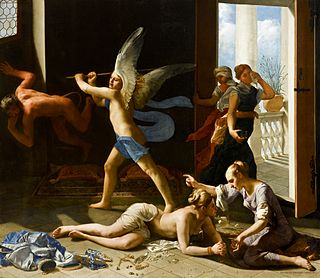
The Repentant Magdalene, also called The Conversion of Mary Magdalene, is an oil painting of the early 1660s by the Baroque Italian painter Guido Cagnacci. It shows Mary Magdalene, beside her remonstrating sister Martha, at the moment she repents, echoed by an allegorical pairing of Virtue, an angel, chasing out Vice, a devil. The painting forms part of the collection of the Norton Simon Museum.
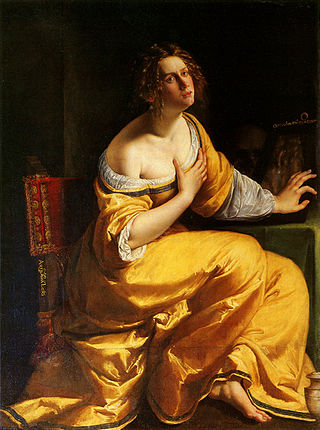
Pentinent Magdalene is a 1616–1618 painting by the Italian baroque artist Artemisia Gentileschi. This painting hangs in the Pitti Palace in Florence. The subject is the biblical figure Mary Magdalene, but the painting references another biblical woman, Mary, the sister of Lazarus. This painting was likely painted in Florence during Gentileschi's Florentine Period.

Mary Magdalene in Ecstasy is a painting by the Italian baroque artist Artemisia Gentileschi. It is in a private European collection.
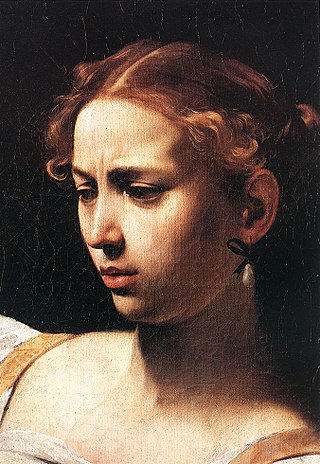
Fillide Melandroni was an Italian courtesan and friend of the painter Caravaggio, who used her as a model in several of his compositions.
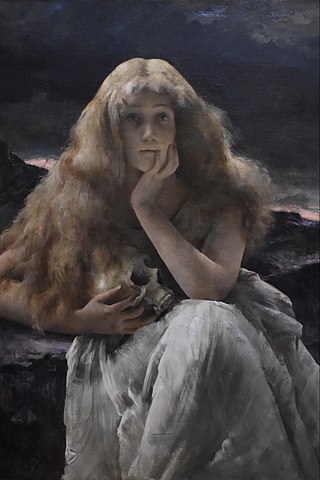
Mary Magdalene is an oil on canvas painting by Belgian painter Alfred Stevens. It is Stevens' revision of the Biblical figure of Mary Magdalene. The work has been in the collection of the Museum of Fine Arts in Ghent since 2001.





















